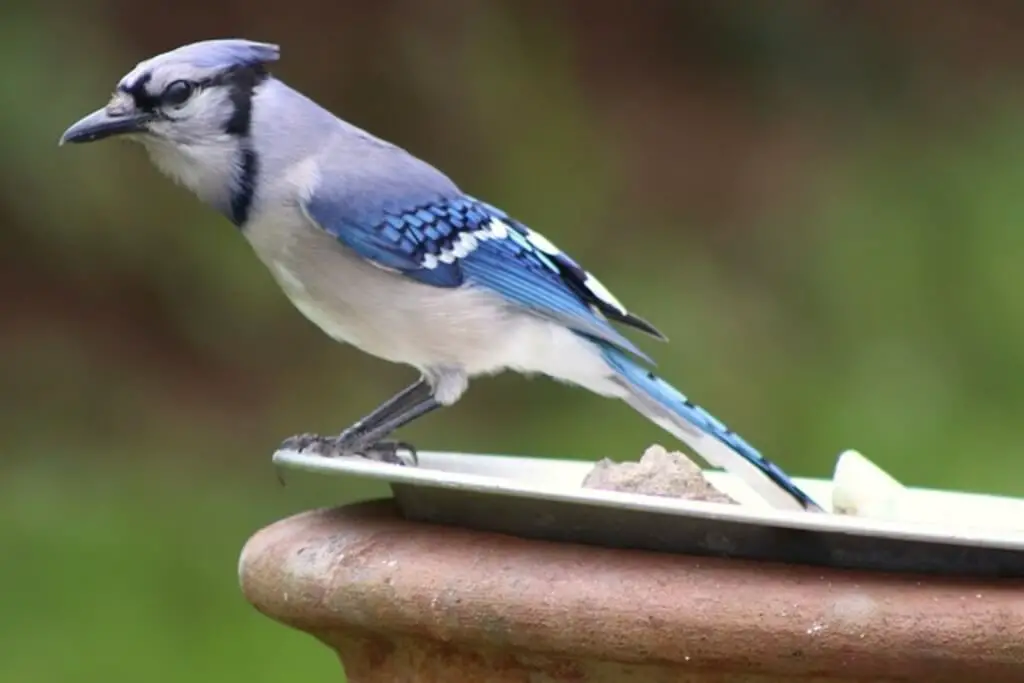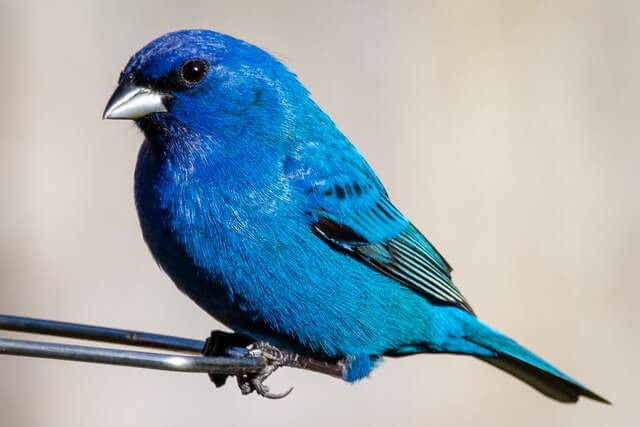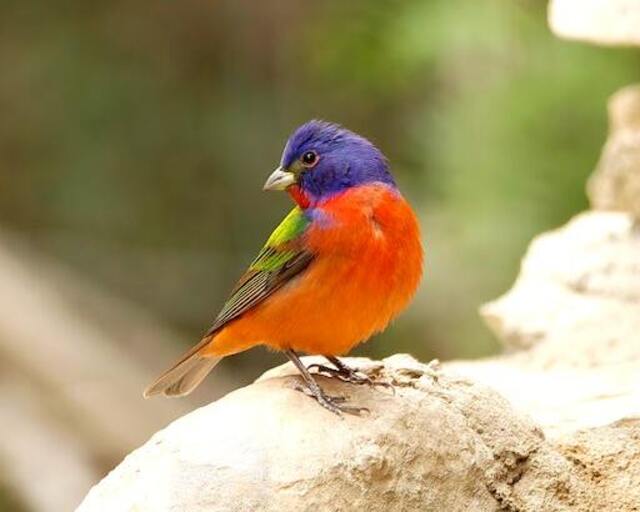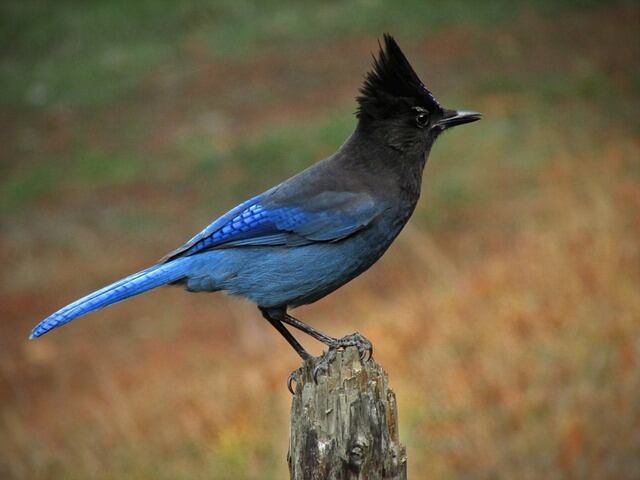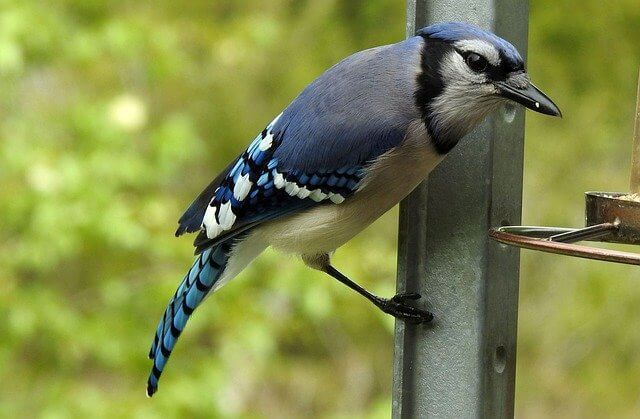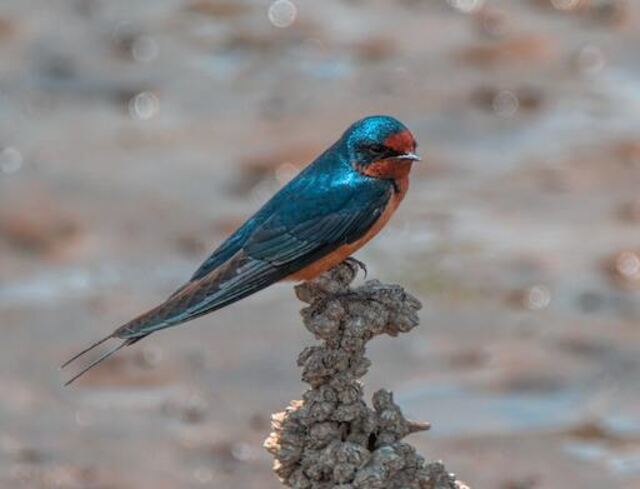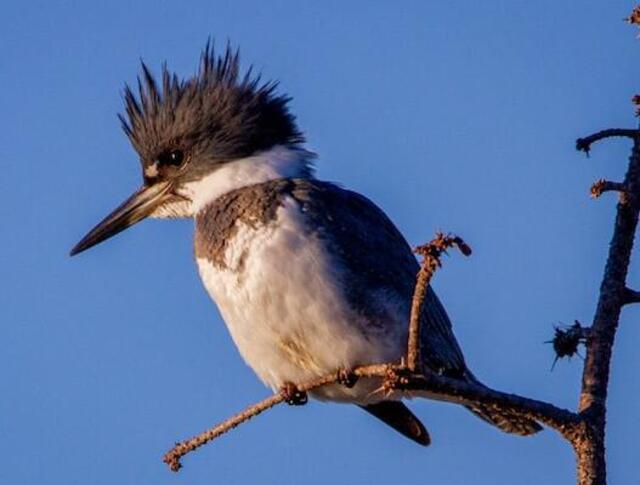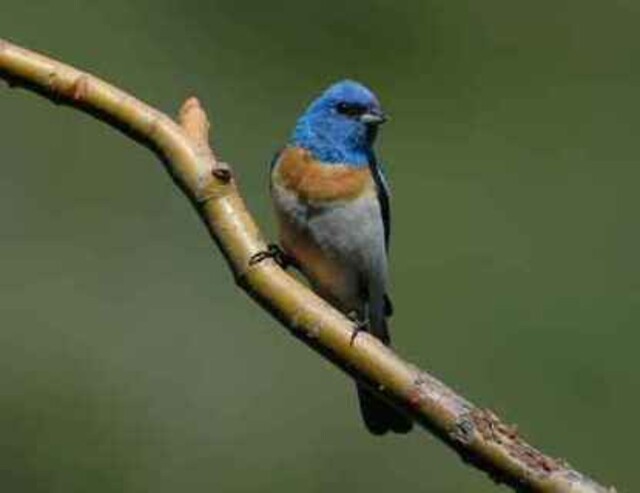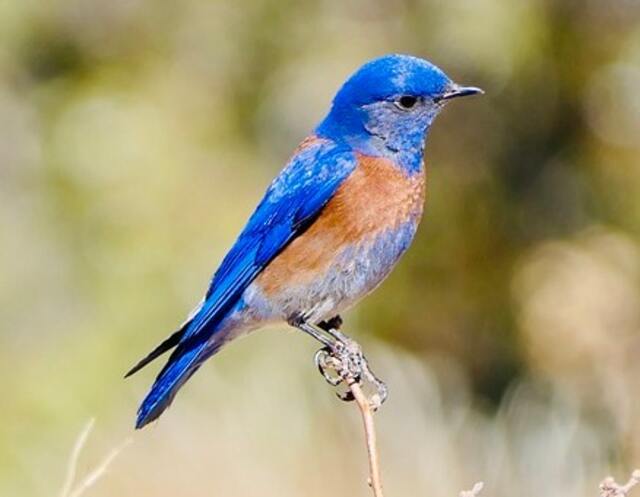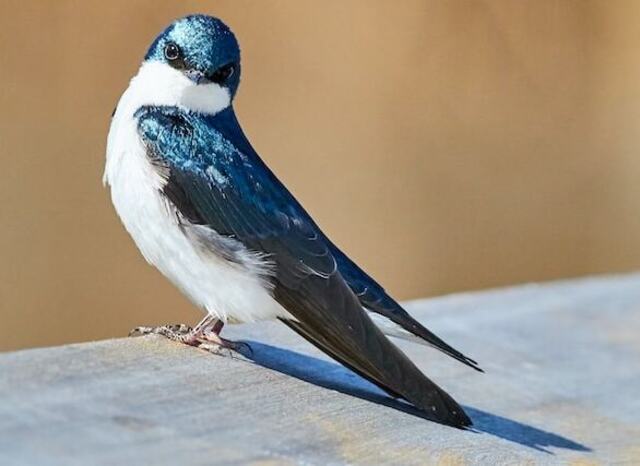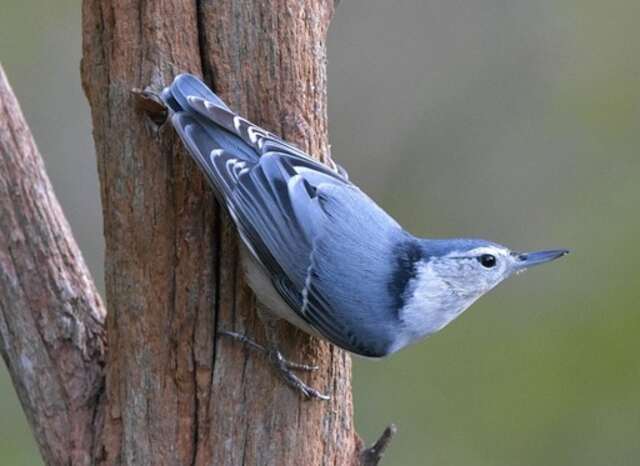Welcome to the world of Washington State’s blue-colored birds! Join us on a journey to discover the sapphire wonders that grace the skies and landscapes of the Pacific Northwest. With 17 unique species, each a gem in its own right, you’re in for a treat.
Get ready to be enchanted by their beauty, learn about their habitats, and explore the magic of birdwatching. Let’s soar into the azure realm of these feathered marvels!
Table of Contents
- 1 Blue Colored Birds In Washington State
- 1.1 Indigo Bunting
- 1.2 Painted Bunting
- 1.3 Pinyon Jay
- 1.4 Stellers Jay
- 1.5 Western Scrub-Jay
- 1.6 Blue Jay
- 1.7 Black-throated Blue Warbler
- 1.8 Barn Swallow
- 1.9 Belted Kingfisher
- 1.10 Lazuli Bunting
- 1.11 Mountain Bluebird
- 1.12 Western Bluebird
- 1.13 Purple Martin
- 1.14 Red-breasted Nuthatch
- 1.15 Rock Pigeon
- 1.16 Tree Swallow
- 1.17 White-breasted Nuthatch
- 2 Conclusion
- 3 Author
Blue Colored Birds In Washington State
Indigo Bunting
| Attribute | Indigo Bunting Measurements |
|---|---|
| Length | Approximately 5.5 inches (14 cm) |
| Weight | About 0.5 – 0.7 ounces (14-20 grams) |
| Wingspan | Approximately 7.5 – 9.1 inches (19-23 cm) |
| Diet | Omnivorous, feeding on seeds, insects, and berries |
| Habitat | Shrubby areas, open woodlands, forest edges |
| Range | Breeds in eastern North America, winters in Central America |
| Plumage | Striking indigo-blue in males, subdued brown in females |
| Song | Known for its melodious and cheerful song |
- Vibrant Visitor: The Indigo Bunting is a vibrantly colored songbird, celebrated for its striking appearance and melodious songs.
- Breeding Range: Found primarily in eastern North America during the breeding season.
- Winter Retreat: Migrates to Central America during the winter months, seeking warmer climates.
- Summer in Washington: During the summer, you have the opportunity to spot Indigo Buntings in Washington. They often grace suburban parks, gardens, and open woodlands in the region.
- Dietary Preferences: This songbird primarily feeds on seeds, insects, and berries, contributing to its ecosystem’s balance.
- Habitat: Indigo Buntings are often seen in shrubby areas, open woodlands, and along forest edges.
- Distinctive Plumage: Males display striking indigo-blue plumage, while females exhibit more subdued brown tones.
- Songbird Serenade: The Indigo Bunting’s melodious song adds a delightful tune to its woodland habitat, making it a favorite among bird enthusiasts.
- Inviting with Feeders: You can enhance your chances of attracting Indigo Buntings by offering suitable feeders and foods. These birds are particularly drawn to feeders stocked with nyjer (thistle) seeds, sunflower seeds, and mealworms. Providing these favored food sources can make your garden an irresistible dining spot for these vibrant visitors.
Painted Bunting
(Passerina ciris)
| Attribute | Painted Bunting Measurements |
|---|---|
| Length | Approximately 4.5 – 5 inches (11-13 cm) |
| Weight | About 0.5 – 0.7 ounces (14-20 grams) |
| Wingspan | Approximately 7.5 – 9 inches (19-23 cm) |
| Diet | Seeds, insects, and berries |
| Habitat | Brushy areas, fields, woodland edges, gardens |
| Range | Breeds in the southeastern United States, migrates to Mexico and Central America for winter |
- Vivid Gem: The Painted Bunting is a gem of the avian world, known for its vibrant and striking plumage.
- Breeding Range: Found predominantly in the southeastern United States during the breeding season.
- Winter Retreat: Migrates to Mexico and Central America for the winter months, seeking warmer climates.
- Summer in Washington: During the summer, lucky observers may spot Painted Buntings in Washington, often in brushy or shrubby areas.
- Dietary Preferences: Their diet primarily consists of seeds, insects, and berries, contributing to their colorful appearance.
- Habitat: Painted Buntings prefer brushy habitats, including fields, woodland edges, and gardens.
- Distinctive Plumage: Males are a kaleidoscope of colors, featuring bright blue heads, green backs, and red underparts. Females have more subdued coloring.
- Songbird Serenade: Painted Buntings are not only visually stunning but also melodious singers, adding a musical dimension to their habitat.
- Inviting with Feeders: Painted Buntings are known to visit feeders, especially when offering seeds like millet and sunflower seeds, or fruit. They can be a delightful sight for bird enthusiasts.
Pinyon Jay
(Gymnorhinus cyanocephalus)
| Attribute | Pinyon Jay Measurement |
|---|---|
| Length | Approximately 10-11 inches (25-28 cm) |
| Weight | About 3 – 4.5 ounces (85-128 grams) |
| Wingspan | Approximately 16-18 inches (41-46 cm) |
| Diet | Primarily pine seeds, nuts, insects, and berries |
| Habitat | Pinyon-juniper woodlands, coniferous forests |
| Range | Western United States, from Idaho to Arizona and New Mexico |
- Distinctive Jay: The Pinyon Jay is a distinctive species known for its unique appearance and habits.
- Habitat: Pinyon Jays are primarily found in pinyon-juniper woodlands and coniferous forests in the western United States.
- Dietary Preferences: Their diet primarily consists of pine seeds (especially pinyon pine seeds), nuts, and occasionally insects and berries.
- Distinctive Appearance: Recognizable by their blue-gray plumage and distinctive pale bills.
- Vocal and Social: Pinyon Jays are highly social birds, often seen in large flocks. They communicate with a variety of calls.
- Nesting Habits: They build nests in conifer trees, constructing bulky nests made of sticks, grasses, and twigs.
- Inviting to Feeders: Pinyon Jays are not commonly seen at traditional bird feeders. However, they may visit if you provide pine seeds or nuts in platform feeders. They have a strong preference for natural food sources.
- Range: Pinyon Jays are native to the western United States, from Idaho and Montana to Arizona and New Mexico.
Stellers Jay
(Cyanocitta stelleri)
| Attribute | Steller’s Jay Measurements |
|---|---|
| Length | Approximately 11-12 inches (28-31 cm) |
| Weight | About 3 – 4.5 ounces (85-128 grams) |
| Wingspan | Approximately 16-18 inches (41-46 cm) |
| Diet | Omnivorous – insects, acorns, seeds, berries, and small vertebrates |
| Habitat | Coniferous and mixed forests, mountainous regions |
| Range | Western North America, from Alaska to northern Mexico |
- Distinctive Jay: The Steller’s Jay is a distinctive and striking bird known for its deep blue plumage and bold personality.
- Habitat: Steller’s Jays are commonly found in coniferous and mixed forests, often in mountainous regions of western North America.
- Dietary Preferences: Their diet primarily consists of insects, acorns, seeds, berries, and occasionally small vertebrates. They are known to be opportunistic foragers.
- Distinctive Appearance: Recognizable by their deep blue plumage with a black crest on their head and white markings.
- Vocal and Assertive: Steller’s Jays are highly vocal birds with a range of calls. They are known for their assertive and curious nature.
- Nesting Habits: They build nests in trees, using twigs, grasses, and leaves to create cup-shaped nests.
- Inviting to Feeders: Steller’s Jays are frequent visitors to bird feeders, especially when offering nuts, seeds, and suet. They can be assertive at feeders.
- Range: Steller’s Jays are native to western North America, from Alaska to northern Mexico.
Western Scrub-Jay
(Aphelocoma californica)
| Attribute | Western Scrub-Jay Measurements |
|---|---|
| Length | Approximately 11-12 inches (28-31 cm) |
| Weight | About 2.5 – 3.5 ounces (70-100 grams) |
| Wingspan | Approximately 13-15 inches (33-38 cm) |
| Diet | Omnivorous – insects, seeds, fruits, small vertebrates |
| Habitat | Chaparral, scrubland, oak woodlands, suburban areas |
| Range | Western North America, from southern Washington to Baja California |
- Distinctive Jay: The Western Scrub-Jay is a distinctive and intelligent bird known for its striking blue plumage and clever behavior.
- Habitat: Western Scrub-Jays are commonly found in a variety of habitats, including chaparral, scrubland, oak woodlands, and suburban areas in western North America.
- Dietary Preferences: Their diet is diverse, including insects, seeds, fruits, and occasionally small vertebrates. They are known to cache food for future consumption.
- Distinctive Appearance: Recognizable by their bright blue plumage with a pale throat and chest, and a long tail.
- Vocal and Curious: Western Scrub-Jays are highly vocal birds with a wide range of calls. They are known for their inquisitive and social nature.
- Nesting Habits: They build nests in trees and shrubs, creating cup-shaped nests made of twigs, leaves, and grass.
- Inviting to Feeders: Western Scrub-Jays are frequent visitors to bird feeders, particularly when offering nuts, seeds, and suet.
- Range: Western Scrub-Jays are native to western North America, from southern Washington to Baja California.
Blue Jay
(Cyanocitta cristata)
| Attribute | Blue Jay’s Measurements |
|---|---|
| Length | Approximately 9-12 inches (23-30 cm) |
| Weight | About 2.5 – 3.5 ounces (70-100 grams) |
| Wingspan | Approximately 13-17 inches (33-43 cm) |
| Diet | Omnivorous – seeds, nuts, insects, small vertebrates, and eggs |
| Habitat | Forests, woodlands, urban and suburban areas, parks |
| Range | Eastern North America, from southern Canada to Florida and westward to Texas |
- Vibrant Avian: The Blue Jay is a vibrant and charismatic bird known for its striking blue plumage and distinctive personality.
- Habitat: Blue Jays are commonly found in a variety of habitats, including forests, woodlands, urban and suburban areas, and parks.
- Dietary Preferences: Their diet is diverse, including seeds, nuts, insects, small vertebrates, and even bird eggs and nestlings.
- Distinctive Appearance: Recognizable by their bright blue feathers, white faces, and black markings. They also have a prominent crest atop their heads.
- Vocal and Social: Blue Jays are known for their loud calls and are highly social birds, often seen in small flocks.
- Nesting Habits: They build nests in trees and shrubs, usually using twigs, grasses, and sometimes feathers.
- Inviting to Feeders: Blue Jays are frequent visitors to bird feeders. They are particularly attracted to feeders stocked with sunflower seeds, peanuts, and suet, making them a delightful addition to backyard birdwatching.
- Range: Blue Jays are native to eastern North America, extending from southern Canada to Florida and westward to Texas.
Black-throated Blue Warbler
(Setophaga caerulescens)
| Attribute | Black-throated Blue Warbler Measurements |
|---|---|
| Length | Approximately 5.1 inches (13 cm) |
| Weight | About 0.4 – 0.5 ounces (11-14 grams) |
| Wingspan | Approximately 7.9 – 8.7 inches (20-22 cm) |
| Diet | Insectivorous, primarily feeding on insects, spiders, and berries |
| Habitat | Deciduous and mixed forests, often in the understory |
| Range | Breeds in eastern North America, migrates to the Caribbean and Central America during the winter months |
- Vibrant Visitor: The Black-throated Blue Warbler is a vibrantly colored songbird known for its striking appearance and melodious songs.
- Breeding Grounds: Found primarily in the eastern parts of North America during the breeding season.
- Winter Retreat: Migrates to the Caribbean and Central America during the winter months, seeking warmer climates.
- Summer in Washington: During the summer, you’ll have the chance to spot Black-throated Blue Warblers in Washington. They often grace suburban parks, forests, and woodlands in the region.
- Dietary Preferences: This warbler primarily feeds on insects, spiders, and berries, making it an essential component of its forest ecosystem.
- Habitat: It is often spotted in deciduous and mixed forests, favoring the understory where it flits among the branches.
- Distinctive Plumage: Recognizable by its deep blue upperparts and a distinctive black throat patch in males, with females having slightly more subdued coloring.
- Songbird Serenade: The Black-throated Blue Warbler’s melodious song is a delight to bird enthusiasts, adding a musical touch to its forest habitat.
- Inviting to Feeders: Attracting Black-throated Blue Warblers to your yard can be achieved by offering suet cakes, peanut butter, or a fruit blend on your feeders. These warblers are known to visit feeders when provided with these food options. Additionally, planting native fruit-bearing trees and shrubs in your garden can create a natural buffet that entices them to stop by for a meal.
Barn Swallow
(Hirundo rustica)
| Attribute | Barn Swallow’s Measurements |
|---|---|
| Length | Approximately 6-7 inches (15-18 cm) |
| Weight | 0.6 – 0.7 ounces (17-20 grams) |
| Wingspan | Approximately 12-13 inches (30-33 cm) |
| Diet | Insectivorous, primarily feeding on flying insects |
| Habitat | Open areas, including fields, meadows, and near bodies of water |
| Range | Breeds in the Northern Hemisphere, winters in the Southern Hemisphere, found on six continents |
- Aerial Marvel: The Barn Swallow is a marvel in the sky, showcasing elegant flight over open fields.
- Global Presence: It’s a globally distributed species, inhabiting six continents. Breeds in the northern hemisphere and winters in the southern hemisphere.
- Summer in Washington: During the summer, Barn Swallows are a common sight in Washington, often found in suburban parks, agricultural fields, and along the state’s beautiful beaches.
- Cobalt Beauty: Their shining cobalt-blue bodies with tawny undersides make them unmistakable.
- Songbird Serenade: Barn Swallows are known for their melodious songs, adding a musical touch to their habitat and delighting bird enthusiasts.
- Feeding Habits: Although not frequenting seed feeders, they might visit if you offer ground-up eggshells on a platform feeder.
- Habitat: You can often spot them in deciduous and mixed forests, particularly in the understory.
- Migratory Patterns: They are known for their seasonal migration, flying north for breeding and south for wintering.
- Inviting to Feeders: While Barn Swallows primarily feed on insects during their aerial forays, you can indirectly attract them to your property by ensuring a healthy insect population. To support these graceful fliers, consider installing a birdbath or a shallow pool of water. Barn Swallows often swoop down to drink and even bathe in flight. Providing a water source can make your yard more appealing to these aerial acrobats.
Belted Kingfisher
(Megaceryle alcyon)
| Attribute | Belted Kingfisher Measurement |
|---|---|
| Length | Approximately 11-13 inches (28-33 cm) |
| Weight | About 4.5 – 6 ounces (128-170 grams) |
| Wingspan | Approximately 19-23 inches (48-58 cm) |
| Diet | Fish, small aquatic creatures, insects |
| Habitat | Freshwater habitats, including rivers, lakes, ponds, coastal areas |
| Range | North and Central America, from Alaska to Panama |
- Fisherman Extraordinaire: The Belted Kingfisher is a skilled and distinctive bird known for its hunting prowess along waterways.
- Habitat: Belted Kingfishers are commonly found near freshwater habitats, including rivers, lakes, ponds, and coastal areas.
- Dietary Preferences: Their diet primarily consists of fish, small aquatic creatures, and insects. They are expert divers and fishermen.
- Distinctive Appearance: Recognizable by their bluish-gray plumage, prominent crests on their heads, and a distinctive white collar or “belt” across their chest.
- Vocal and Watchful: Belted Kingfishers are known for their loud, rattling calls and vigilant hunting behavior.
- Nesting Habits: They often nest in burrows they excavate in sandy or earthen banks near water. The burrows can be several feet long.
- Inviting to Sight: Belted Kingfishers are best observed near water bodies, where their distinct hunting and diving behavior can be witnessed.
- Range: Belted Kingfishers are native to North and Central America, extending from Alaska to Panama.
Lazuli Bunting
(Passerina amoena)
| Attribute | Lazuli Bunting Measurements |
|---|---|
| Length | Approximately 5.5 – 6 inches (14-15 cm) |
| Weight | About 0.5 – 0.7 ounces (14-20 grams) |
| Wingspan | Approximately 8 – 8.5 inches (20-22 cm) |
| Diet | Insects, seeds, berries |
| Habitat | Open woodlands, shrubby areas, along streams |
| Range | Breeds in western North America, migrates to Mexico and Central America for winter |
- Vibrant Beauty: The Lazuli Bunting is a vibrantly colored songbird celebrated for its stunning appearance and melodious songs.
- Breeding Grounds: Found primarily in western North America during the breeding season.
- Winter Retreat: Migrates to Mexico and Central America during the winter months, seeking warmer climates.
- Summer in Washington: During the summer, you’ll have the chance to spot Lazuli Buntings in Washington, often gracing open woodlands and shrubby habitats.
- Dietary Preferences: This bunting primarily feeds on insects, seeds, and berries, making it an important contributor to its ecosystem.
- Habitat: Lazuli Buntings are often found in open woodlands, shrubby areas, and along streams.
- Distinctive Plumage: Males are known for their brilliant azure-blue plumage with a striking chestnut patch on their shoulders, while females have more subdued coloring.
- Songbird Serenade: The Lazuli Bunting’s melodious song is a delight to bird enthusiasts, filling its habitat with beautiful music.
Mountain Bluebird
(Sialia currucoides)
| Attribute | Mountain Bluebird Measurements |
|---|---|
| Length | Approximately 6.5 – 7.5 inches (17-19 cm) |
| Weight | About 1 – 1.1 ounces (28-31 grams) |
| Wingspan | Approximately 13 inches (33 cm) |
| Diet | Insects (grasshoppers, beetles), berries |
| Habitat | Mountain meadows, grasslands, sagebrush steppe |
| Range | North America, from Alaska to northern Mexico |
- Sky-Blue Marvel: The Mountain Bluebird is a stunning and iconic bird known for its brilliant azure-blue plumage.
- Habitat: Mountain Bluebirds are commonly found in open habitats, including mountain meadows, grasslands, and sagebrush steppe.
- Dietary Preferences: Their diet primarily consists of insects, including grasshoppers and beetles, and occasionally berries.
- Distinctive Appearance: Recognizable by their vibrant sky-blue plumage, with males being more intensely colored than females.
- Vocal and Graceful: Mountain Bluebirds are known for their soft, melodious calls and graceful flight.
- Nesting Habits: They often nest in tree cavities or man-made nest boxes, where they create cup-shaped nests made of grasses and feathers.
- Inviting to Sight: Mountain Bluebirds are best observed in open, rural areas where they perch prominently and forage for insects.
- Range: Mountain Bluebirds are native to North America, with a range extending from Alaska to northern Mexico.
Western Bluebird
(Sialia mexicana)
| Attribute | Western Bluebird Measurements |
|---|---|
| Length | Approximately 6 – 7 inches (15-18 cm) |
| Weight | About 1 – 1.2 ounces (28-34 grams) |
| Wingspan | Approximately 11 – 13 inches (28-33 cm) |
| Diet | Insects, spiders, berries |
| Habitat | Woodlands, grasslands, orchards |
| Range | Western North America, from British Columbia to Baja California |
- Western Gem: The Western Bluebird is a charming and colorful bird known for its vibrant plumage and cheerful demeanor.
- Habitat: Western Bluebirds are commonly found in open habitats, including woodlands, grasslands, and orchards in western North America.
- Dietary Preferences: Their diet primarily consists of insects, spiders, and berries. They are skilled hunters of insects.
- Distinctive Appearance: Recognizable by their brilliant azure-blue plumage on their heads, wings, and tails, with orange-brown chests in males.
- Vocal and Cheerful: Western Bluebirds are known for their melodious calls and cheerful songs, adding a pleasant ambiance to their habitat.
- Nesting Habits: They often nest in natural tree cavities or man-made nest boxes, creating cup-shaped nests made of grasses and feathers.
- Inviting to Sight: Western Bluebirds are best observed in open woodlands and grasslands where they forage for insects and perch on branches.
- Range: Western Bluebirds are native to western North America, from British Columbia to Baja California.
Purple Martin
(Progne subis)
| Attribute | Purple Martin Measurements |
|---|---|
| Length | Approximately 7.5 – 8.5 inches (19-22 cm) |
| Weight | About 1.5 – 2.2 ounces (43-62 grams) |
| Wingspan | Approximately 15 – 16 inches (38-41 cm) |
| Diet | Flying insects, including dragonflies, moths, and beetles |
| Habitat | Open habitats near water, including marshes, lakeshores, and open woodlands |
| Range | Breeding in North America, wintering in South America |
- Aerial Acrobats: Purple Martins are captivating birds known for their aerial displays and communal nesting habits.
- Habitat: Purple Martins are typically found in open habitats near water, including marshes, lakeshores, and open woodlands.
- Dietary Preferences: Their diet primarily consists of flying insects, such as dragonflies, moths, and beetles, which they catch in mid-air.
- Distinctive Appearance: Recognizable by their deep purple-blue plumage in males and grayish-blue plumage in females.
- Vocal and Social: Purple Martins are known for their chattering calls and social behavior, often nesting in colonies of birdhouses.
- Nesting Habits: They often nest in man-made birdhouses specifically designed for them. These houses can be found in many areas where Purple Martins are encouraged.
- Inviting to Watch: Purple Martins are best observed near their communal nest sites, where they engage in aerial displays while hunting insects.
- Range: Purple Martins are native to North and South America, breeding in North America and wintering in South America.
Red-breasted Nuthatch
(Sitta canadensis)
| Attribute | Red-breasted Nuthatch Measurements |
|---|---|
| Length | Approximately 4.5 – 5 inches (11-13 cm) |
| Weight | About 0.5 – 0.6 ounces (14-17 grams) |
| Wingspan | Approximately 8 inches (20 cm) |
| Diet | Insects, seeds, nuts, particularly conifer seeds |
| Habitat | Coniferous forests |
| Range | North America, from Alaska to the southern United States |
- Tiny Acrobat: The Red-breasted Nuthatch is a small, agile bird known for its acrobatic foraging behavior.
- Habitat: Red-breasted Nuthatches are commonly found in coniferous forests across North America.
- Dietary Preferences: Their diet primarily consists of insects, seeds, and nuts, with a particular fondness for conifer seeds.
- Distinctive Appearance: Recognizable by their blue-gray upperparts, reddish-orange chest, and distinctive black eyeline.
- Vocal and Energetic: Red-breasted Nuthatches are known for their nasal calls and energetic foraging habits, often seen upside down on tree trunks.
- Nesting Habits: They build nests in tree cavities, using bark, grasses, and feathers to create cozy nests.
- Inviting to Watch: Red-breasted Nuthatches are best observed in coniferous forests, where they climb tree trunks and branches in search of food.
- Range: Red-breasted Nuthatches are native to North America, with a range extending from Alaska to the southern United States.
Rock Pigeon
(Columba livia)
| Attribute | Rock Pigeon Measurements |
|---|---|
| Length | Approximately 11 – 13 inches (28-33 cm) |
| Weight | About 9 – 13 ounces (250-370 grams) |
| Wingspan | Approximately 20 – 26 inches (51-66 cm) |
| Diet | Seeds, grains, human-provided food scraps |
| Habitat | Urban and rural environments, cliffs, coastal regions |
| Range | Worldwide, with populations in urban areas across North America, Europe, Asia, and more |
- Urban Survivor: The Rock Pigeon, also known as the Rock Dove, is a resilient bird often found in urban areas worldwide.
- Habitat: Rock Pigeons are highly adaptable and can be found in a variety of urban and rural environments, including cities, cliffs, and coastal regions.
- Dietary Preferences: Their diet primarily consists of seeds, grains, and human-provided food scraps.
- Distinctive Appearance: Recognizable by their gray-blue plumage, iridescent neck feathers, and distinctive markings on their wings.
- Vocal and Gregarious: Rock Pigeons are known for their cooing calls and their tendency to gather in flocks, especially in urban settings.
- Nesting Habits: They often nest on ledges, buildings, and cliffs, creating simple nests of sticks and twigs.
- Inviting to Urban Areas: Rock Pigeons are commonly seen in city parks and plazas, making them easily accessible to urban birdwatchers.
- Range: Rock Pigeons are found worldwide, with populations in urban areas across North America, Europe, Asia, and other continents.
Tree Swallow
(Tachycineta bicolor)
| Attribute | Tree Swallow Measurements |
|---|---|
| Length | Approximately 5.5 – 6.5 inches (14-17 cm) |
| Weight | About 0.6 – 0.9 ounces (17-26 grams) |
| Wingspan | Approximately 11 – 13 inches (28-33 cm) |
| Diet | Flying insects, including flies, beetles, and moths |
| Habitat | Wetlands, marshes, meadows, open habitats near water |
| Range | North and Central America, breeding from Alaska to Mexico |
- Aerial Acrobat: The Tree Swallow is a graceful and agile bird known for its acrobatic flight and striking blue-green plumage.
- Habitat: Tree Swallows are commonly found in open habitats near water, including wetlands, marshes, and meadows.
- Dietary Preferences: Their diet primarily consists of flying insects, which they catch in mid-air during their remarkable aerial foraging.
- Distinctive Appearance: Recognizable by their iridescent blue-green upperparts and white underparts, with a slightly forked tail.
- Vocal and Sociable: Tree Swallows are known for their soft, melodious calls and their tendency to nest in colonies in tree cavities or nest boxes.
- Nesting Habits: They often build nests in natural tree cavities, nest boxes, or even abandoned woodpecker holes, using grasses and feathers to create cup-shaped nests.
- Inviting to Watch: Tree Swallows are best observed near their nesting sites, where they perform dazzling aerial displays while hunting insects.
- Range: Tree Swallows are native to North and Central America, with breeding populations extending from Alaska to Mexico.
White-breasted Nuthatch
(Sitta carolinensis)
| Attribute | White-breasted Nuthatch Measurements |
|---|---|
| Length | Approximately 5.5 – 6 inches (14-15 cm) |
| Weight | About 0.7 – 1 ounce (20-28 grams) |
| Wingspan | Approximately 9.5 – 11 inches (24-28 cm) |
| Diet | Insects, seeds, nuts, particularly sunflower seeds |
| Habitat | Deciduous and coniferous forests, suburban areas with suitable trees |
| Range | North America, from southern Canada to Mexico |
- Woodland Acrobat: The White-breasted Nuthatch is a skilled and agile bird known for its unique foraging behavior on tree trunks.
- Habitat: White-breasted Nuthatches are commonly found in deciduous and coniferous forests, as well as suburban areas with suitable trees.
- Dietary Preferences: Their diet primarily consists of insects, seeds, and nuts, with a particular preference for sunflower seeds.
- Distinctive Appearance: Recognizable by their blue-gray upperparts, white underparts, and black cap on their heads.
- Vocal and Energetic: White-breasted Nuthatches are known for their nasal calls and their habit of moving quickly along tree trunks and branches.
- Nesting Habits: They often nest in tree cavities, using bark, grasses, and feathers to create cup-shaped nests.
- Inviting to Feeders: White-breasted Nuthatches are frequent visitors to bird feeders, especially when offering sunflower seeds or suet.
- Range: White-breasted Nuthatches are native to North America, with a range extending from southern Canada to Mexico.
Conclusion
In conclusion, the diverse array of blue-colored birds in Washington State adds a vibrant and captivating element to its avian population. These birds, with their striking hues and unique behaviors, contribute to the rich tapestry of the state’s natural beauty and provide endless opportunities for birdwatchers and nature enthusiasts to appreciate and admire their presence in the Pacific Northwest.

